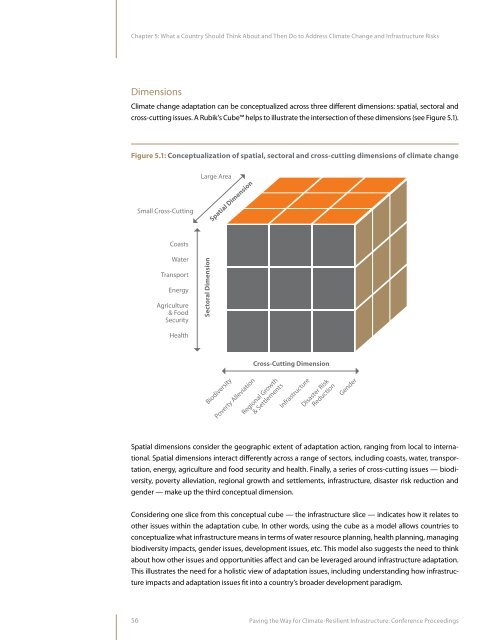Paving the Way for Climate-Resilient Infrastructure - UN CC:Learn
Paving the Way for Climate-Resilient Infrastructure - UN CC:Learn
Paving the Way for Climate-Resilient Infrastructure - UN CC:Learn
You also want an ePaper? Increase the reach of your titles
YUMPU automatically turns print PDFs into web optimized ePapers that Google loves.
Chapter 5: What a Country Should Think About and Then Do to Address <strong>Climate</strong> Change and <strong>Infrastructure</strong> RisksDimensions<strong>Climate</strong> change adaptation can be conceptualized across three different dimensions: spatial, sectoral andcross-cutting issues. A Rubik’s Cube helps to illustrate <strong>the</strong> intersection of <strong>the</strong>se dimensions (see Figure 5.1).Figure 5.1: Conceptualization of spatial, sectoral and cross-cutting dimensions of climate changeSmall Cross-CuttingLarge AreaSpatial DimensionCoastsWaterTransportEnergyAgriculture& FoodSecuritySectoral DimensionHealthBiodiversityPoverty AlleviationCross-Cutting DimensionRegional Growth& Settlements<strong>Infrastructure</strong>Disaster RiskReductionGenderSpatial dimensions consider <strong>the</strong> geographic extent of adaptation action, ranging from local to international.Spatial dimensions interact differently across a range of sectors, including coasts, water, transportation,energy, agriculture and food security and health. Finally, a series of cross-cutting issues — biodiversity,poverty alleviation, regional growth and settlements, infrastructure, disaster risk reduction andgender — make up <strong>the</strong> third conceptual dimension.Considering one slice from this conceptual cube — <strong>the</strong> infrastructure slice — indicates how it relates too<strong>the</strong>r issues within <strong>the</strong> adaptation cube. In o<strong>the</strong>r words, using <strong>the</strong> cube as a model allows countries toconceptualize what infrastructure means in terms of water resource planning, health planning, managingbiodiversity impacts, gender issues, development issues, etc. This model also suggests <strong>the</strong> need to thinkabout how o<strong>the</strong>r issues and opportunities affect and can be leveraged around infrastructure adaptation.This illustrates <strong>the</strong> need <strong>for</strong> a holistic view of adaptation issues, including understanding how infrastructureimpacts and adaptation issues fit into a country’s broader development paradigm.56<strong>Paving</strong> <strong>the</strong> <strong>Way</strong> <strong>for</strong> <strong>Climate</strong>-<strong>Resilient</strong> <strong>Infrastructure</strong>: Conference Proceedings
















